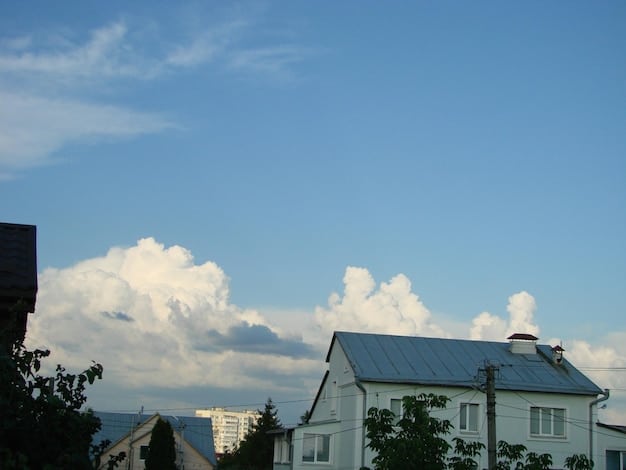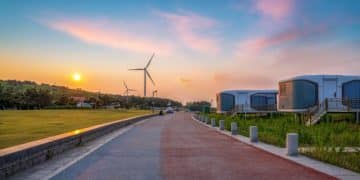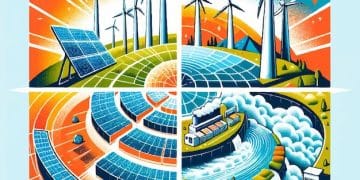How Updated US Energy Policy Will Impact Your 2025 Bills

The updated US energy policy for 2025, driven by a blend of renewable incentives and strategic fossil fuel adjustments, is projected to introduce a multifaceted impact on household energy bills, varying by regional energy mix and individual consumption patterns.
As 2025 approaches, many Americans are scrutinizing their budgets, and a key question arises: How will the updated US energy policy affect your 2025 energy bills? Understanding the nuances of recent legislative changes and their ripple effects across the energy landscape is crucial for preparing your household finances. This deep dive aims to unravel the complexities, offering clarity on potential shifts in your utility statements.
Navigating the Landscape of US Energy Policy Shifts
The United States energy policy is a dynamic and intricate web, constantly evolving in response to economic pressures, environmental concerns, technological advancements, and geopolitical realities. For 2025, a confluence of factors, ranging from the implementation of existing legislation to emerging regulatory frameworks, is set to redefine how energy is produced, distributed, and consumed across the nation. These shifts are not merely high-level governmental decisions; they directly influence the operational costs of utility companies, the availability and pricing of different energy sources, and ultimately, the monthly bills received by millions of households. Understanding this foundational landscape is the first step in deciphering the future of your energy expenditures. We are seeing a concerted effort to balance energy security with sustainability goals, which often creates tensions and requires careful policy calibration.
While the broad strokes of US energy policy often focus on national objectives, their impact invariably trickles down to the everyday consumer. For instance, federal incentives for renewable energy deployment, while aimed at reducing carbon emissions, can also lead to increased investment in infrastructure, which might initially contribute to slight cost adjustments before long-term savings are realized. Conversely, policies affecting fossil fuel production, such as new drilling regulations or subsidies, directly influence the supply and price volatility of traditional energy sources. The challenge lies in translating these macro-economic and environmental ambitions into tangible effects on individual energy bills, a process influenced heavily by regional energy mixes and state-level regulatory environments. This intricate interplay necessitates a detailed examination of both federal mandates and local market dynamics to accurately project future costs.
Federal Initiatives Shaping the 2025 Outlook
- Cleaner Energy Incentives: Tax credits and rebates designed to encourage the adoption of solar panels, wind energy, and energy-efficient appliances.
- Infrastructure Modernization: Investments in grid upgrades to enhance reliability, reduce transmission losses, and integrate diverse energy sources.
- Fossil Fuel Regulations: New standards for emissions and extraction, potentially impacting production costs and energy supply.
Ultimately, the goal of many of these policy adjustments is to create a more resilient, sustainable, and affordable energy system. However, the path to achieving these goals is rarely straightforward. There are always trade-offs and transition costs that must be managed. For consumers, this means remaining informed about the specific policies being enacted and understanding how they might translate into changes in their energy bills. The journey toward a modernized energy future is complex, demanding both patience and proactive engagement from all stakeholders, including individual households.
The Direct Impact on Your Utility Statements
The complex tapestry of US energy policy changes is bound to manifest itself in tangible ways on your utility bills. Pinpointing the exact figure by which your bill might increase or decrease is challenging, given the multitude of variables at play, but understanding the mechanisms of these changes is key. For many households, the most direct impact will stem from changes in the cost of generation, transmission, and distribution, influenced by federal mandates and market forces. Renewable energy integration, for example, can introduce new charges related to grid modernization and capacity upgrades, even as it promises long-term savings through reduced reliance on volatile fossil fuel markets. It’s a delicate balance of short-term adjustments for long-term benefits.
The structure of energy bills themselves may also evolve. We might see new line items reflecting investments in smart grid technologies, cybersecurity for energy infrastructure, or even carbon pricing mechanisms in some regions. These additions, while potentially increasing the complexity of your bill, are often aimed at improving service reliability, promoting energy efficiency, or contributing to broader environmental goals. On the other hand, federal and state incentives for energy efficiency improvements, such as home insulation upgrades or the adoption of ENERGY STAR appliances, offer avenues for consumers to actively reduce their consumption and, consequently, their bills, offsetting some of these potential increases. The interaction between policy-driven costs and consumer-led savings will largely determine the net effect.
Understanding Bill Components
- Generation Costs: Reflects the price of producing electricity, influenced by fuel costs, power plant operations, and renewable energy mandates.
- Transmission & Distribution: Covers the cost of maintaining and operating the grid that delivers electricity to your home.
- Taxes & Fees: Various federal, state, and local taxes, as well as charges for specific programs or services.
Ultimately, the goal of many of these policy adjustments is to create a more resilient, sustainable, and affordable energy system. However, the path to achieving these goals is rarely straightforward. There are always trade-offs and transition costs that must be managed. For consumers, this means remaining informed about the specific policies being enacted and understanding how they might translate into changes in their energy bills. The journey toward a modernized energy future is complex, demanding both patience and proactive engagement from all stakeholders, including individual households.
Renewable Energy: A Double-Edged Sword for Consumers
The push towards renewable energy sources like solar and wind power is a cornerstone of the updated US energy policy, driven by environmental responsibility and the desire for energy independence. For consumers, this transition presents a nuanced financial picture. In the short term, the substantial investments required for developing new renewable infrastructure, upgrading existing grids to accommodate intermittent energy sources, and integrating these technologies can create upward pressure on energy costs. These initial outlays may be reflected in higher distribution charges or new fees on utility bills, as providers seek to recover their capital investments. This is a common challenge in any large-scale infrastructure transformation, where the initial costs of modernization precede the long-term benefits.
However, the long-term outlook for renewable energy is generally optimistic for consumers. Once established, renewable power plants typically have lower operational costs compared to fossil fuel facilities, as they are not subject to the volatile price fluctuations of coal, oil, or natural gas. This stability can lead to more predictable and potentially lower electricity rates over time. Furthermore, federal and state incentives, such as tax credits for rooftop solar installations or rebates for purchasing renewable energy certificates, can enable individual households to reduce their energy consumption from the grid or even become net energy producers, significantly lowering their bills. The shift requires a forward-looking perspective, balancing immediate investments with future savings.

Another critical aspect of renewable energy’s impact is its effect on energy market competition. As more renewable sources come online, they diversify the energy supply, which can reduce the market power of traditional utility monopolies and encourage more competitive pricing. This increased competition, combined with advancements in battery storage technology, also helps address the intermittency challenge of renewables, making the grid more resilient and reducing the reliance on costly peaker plants often fueled by fossil fuels. For instance, the expansion of community solar programs in some states allows even renters or those without suitable rooftops to benefit from renewable energy savings, indirectly impacting their energy bills through participation fees or credits.
It is important for consumers to recognize that the transition to a renewable-heavy grid is a phased process. Initial capital expenditure is frontloaded, creating potential for temporary rate increases. Yet, as the infrastructure matures and the share of renewables in the energy mix grows, the benefits of lower operating costs, reduced fuel price volatility, and enhanced energy independence are expected to translate into more stable and ultimately more affordable energy for the majority. Therefore, while some may see slight increases initially, the broader trajectory points towards a more economically advantageous energy future, especially for those who actively participate in efficiency programs or adopt personal renewable solutions.
Fossil Fuels: A Shifting Landscape of Costs and Availability
Despite the growing emphasis on renewables, fossil fuels—natural gas, coal, and oil—continue to play a substantial role in the US energy mix, and policy changes directly affecting them will inevitably impact your energy bills. The updated US energy policy for 2025 seeks to balance continued reliance on these traditional sources with a push towards cleaner alternatives. For example, new regulations on methane emissions from oil and gas operations, while critical for environmental protection, can increase production costs for suppliers. These elevated costs are often passed on to consumers, leading to higher natural gas prices for heating and electricity generation, which then reflect on monthly utility statements. It’s a classic economic trade-off, where environmental benefits come with an immediate financial adjustment.
Conversely, efforts to streamline permitting processes for new natural gas pipelines or to expand domestic oil production could potentially stabilize or even reduce prices in the short term, by increasing supply. However, such policies often face environmental opposition and could be subject to reversals, introducing volatility into the market. The geopolitical landscape also heavily influences fossil fuel prices; international conflicts or supply chain disruptions can rapidly drive up global oil and gas costs, impacts that domestic policy can mitigate but not entirely eliminate. Consumers dependent on natural gas for heating or electricity will thus remain sensitive to both domestic regulatory shifts and global market dynamics.
Key Factors Affecting Fossil Fuel Costs
- Regulatory Compliance: Costs associated with meeting new environmental standards for emissions and waste management.
- Supply Chain Dynamics: Disruptions in extraction, refining, or transportation that affect availability and price.
- Geopolitical Events: Global conflicts or economic shifts that impact international oil and gas markets.
Moreover, the gradual phase-out of coal-fired power plants, driven by environmental policies and the economic competitiveness of natural gas and renewables, might shift electricity generation towards other sources. While this transition can lead to cleaner air, it also means that regions heavily reliant on coal may experience adjustments in their energy infrastructure and pricing models. The net effect on bills will depend on the cost of the replacement energy source and the investment required for the transition. For many, this represents a period of uncertainty, as the energy mix of particular regions evolves, leading to differing impacts on household budgets depending on their location and energy providers.
The interaction between fossil fuel policies and renewable energy mandates creates a complex pricing environment. As renewables become more prevalent, they can displace some fossil fuel demand, potentially stabilizing prices. However, if the transition is managed poorly, or if regulations disproportionately increase fossil fuel costs without robust renewable alternatives readily available, consumers could face higher bills. Therefore, the strategic implementation of these policies, coupled with market responsiveness, will be crucial in determining the ultimate financial burden or benefit for households in 2025 and beyond.
Energy Efficiency and Smart Homes: Your Role in Cost Control
In the context of evolving US energy policy and its potential impact on your bills, embracing energy efficiency and smart home technologies emerges as a powerful strategy for consumers to actively control their expenditures. Federal and state policies are increasingly offering incentives for households to reduce their energy footprint, transforming passive energy consumption into an opportunity for active financial management. These incentives can range from tax credits for upgrading to high-efficiency windows and insulation to rebates on smart thermostats and ENERGY STAR rated appliances. By taking advantage of such programs, homeowners can significantly lower their overall energy consumption, directly translating into reduced monthly utility bills, regardless of broader market fluctuations.
Smart home technologies, in particular, offer a granular level of control over energy usage that was previously unavailable. Smart thermostats, for instance, can learn household preferences and optimize heating and cooling schedules, often reducing energy waste by automatically adjusting temperatures when residents are away or asleep. Smart lighting systems allow for remote control and scheduling, providing energy savings that accumulate over time. The integration of these devices into a cohesive smart home ecosystem can offer real-time insights into energy consumption, empowering residents to identify and eliminate inefficiencies. This proactive approach to energy management is a vital component in mitigating the financial effects of policy changes.
Top Energy Efficiency Upgrades
- Smart Thermostats: Optimize heating and cooling cycles based on occupancy and preferences.
- LED Lighting: Consume significantly less energy than incandescent bulbs and last much longer.
- Improved Insulation: Reduce heat loss in winter and heat gain in summer, lowering HVAC demands.
- High-Efficiency Appliances: ENERGY STAR certified appliances use less energy for the same tasks.
Beyond individual devices, policies often encourage holistic home energy audits, which can identify systemic inefficiencies and recommend comprehensive solutions. These audits, sometimes subsidized or offered at a reduced rate by utilities, provide a roadmap for substantial energy savings. For example, sealing air leaks in attics and crawl spaces, upgrading outdated water heaters, or replacing aging HVAC systems are large-scale improvements that yield significant returns. The initial investment in these upgrades might seem substantial, but the long-term savings, often augmented by ongoing policy incentives, make them financially prudent decisions for any homeowner looking to stabilize or reduce their energy costs in the face of policy-driven shifts.
Moreover, the adoption of electric vehicles (EVs) and associated charging infrastructure also features prominently in future energy policies. While traditionally viewed as a transportation expense, charging an EV at home can impact your electricity bill. Policies designed to encourage EV adoption often include incentives for off-peak charging, which can help manage grid demand and potentially offer lower charging rates for consumers. Taking advantage of these programs ensures that the shift to electric transportation aligns with personal financial goals, preventing unexpected spikes in energy bills and leveraging electrification as another avenue for smarter energy use.
Regional Disparities: Location, Location, Location
The impact of updated US energy policy on your 2025 energy bills will not be uniform across the nation; regional disparities play a crucial role. The United States is a vast country with diverse climates, energy mixes, economic structures, and regulatory environments, all of which contribute to how federal policies are implemented and how market forces unfold locally. For instance, states heavily reliant on coal power, often found in the Midwest and parts of the Southeast, may experience different bill impacts compared to states that have already significantly transitioned to natural gas or renewable energy, like those in the Northeast or California. The legacy infrastructure and generation portfolio of a region dictate the cost and feasibility of transitioning to newer, cleaner energy sources.
States with aggressive renewable energy mandates, while potentially benefiting from long-term stability and environmental gains, might see initial rate increases to fund the necessary infrastructure development and grid upgrades. Conversely, regions rich in natural gas resources may continue to benefit from relatively lower fuel costs for electricity generation, assuming regulatory conditions remain favorable to extraction. Therefore, a household in Arizona, with abundant solar potential and sunshine, will likely experience different price signals and policy incentives than one in New York, where hydropower or wind might be more prevalent. These differing energy landscapes mean that national policies are filtered through a local lens.
Factors Influencing Regional Energy Costs
- State-Specific Regulations: Varying renewable portfolio standards, carbon pricing, and energy efficiency mandates.
- Local Energy Mix: The prevailing sources of electricity generation (coal, nuclear, gas, solar, wind, hydro) in a given region.
- Climate Conditions: Extreme weather events or prolonged heating/cooling seasons that drive up demand.
- Infrastructure Development: The age and capacity of existing grids and the need for new transmission lines.
Furthermore, the structure of energy markets differs significantly between states. Some states operate in fully regulated markets where utilities own generation, transmission, and distribution, with rates set by public utility commissions. Others have deregulated markets, allowing consumers to choose their electricity supplier, potentially fostering competition and offering more varied pricing plans. The effectiveness of federal policy changes, such as tax credits for renewable energy, can vary based on whether these credits are absorbed by a vertically integrated utility or passed directly to consumers in a competitive retail market. This introduces yet another layer of complexity for consumers trying to predict their future energy costs.
Ultimately, understanding your local energy market, your state’s specific energy policies, and the prevailing energy sources in your region is paramount to forecasting the personal impact of updated US energy policy. While federal directives set the overarching direction, the localized implementation and market response will be the primary determinants of whether your energy bills go up, down, or remain relatively stable in 2025. Engaging with local utility information and state energy office resources can provide more tailored insights into your specific situation.
Preparing Your Household for 2025 Energy Costs
As the updated US energy policy takes shape for 2025, proactive preparation can significantly cushion your household against potential increases in energy bills or allow you to maximize savings. The dynamic nature of energy markets and policy shifts demands a strategic approach from consumers, transitioning from passive recipients of energy services to active participants in managing their consumption and costs. One of the most effective initial steps is to conduct a thorough energy audit of your home, either professionally or through self-assessment. Identifying areas of energy waste—such as poor insulation, inefficient appliances, or air leaks—provides a clear roadmap for improvements that will yield tangible savings. Many utilities offer free or subsidized energy audits, making this an accessible starting point.
Beyond physical home improvements, understanding your current energy usage patterns is crucial. Many utility companies provide detailed online portals or smart meter data that can illustrate peak usage times and historical consumption. Analyzing this data can help you adjust daily habits, such as doing laundry during off-peak hours when electricity rates might be lower, or conscientiously unplugging phantom load devices. Adopting a mindset of conscious consumption, where every kilowatt-hour used is considered, can lead to surprisingly significant savings over time. This approach not only helps your wallet but also reinforces broader energy conservation goals promoted by policy changes.
Actionable Steps for Households
- Monitor Energy Usage: Regularly review utility statements and smart meter data to identify trends and adjust habits.
- Explore Renewable Options: Investigate local solar programs, community solar, or incentives for residential solar installation.
- Update Appliances: Replace older, inefficient appliances with ENERGY STAR certified models.
- Seal and Insulate: Improve your home’s thermal envelope by sealing drafts and adding insulation.
Furthermore, exploring opportunities for utilizing renewable energy directly, even at a small scale, can be beneficial. Research state and federal incentives for rooftop solar panels, community solar programs, or other renewable energy initiatives in your area. While the initial investment for solar can be substantial, the long-term energy independence and potential for significant bill reductions, amplified by tax credits and rebates, often make it an attractive option. Even for renters, participating in community solar projects can provide access to renewable energy benefits without needing to own a property.
Finally, staying informed about local and state energy policies is paramount. Public utility commissions often hold hearings on proposed rate increases or new energy programs, and community engagement can sometimes influence these decisions. Subscribing to newsletters from your utility provider or state energy office can keep you abreast of changes that specifically affect your region and provide information on new rebate programs or energy-saving initiatives. By combining energy efficiency upgrades, smart consumption habits, and informed decision-making, households can effectively navigate the evolving energy landscape of 2025 and beyond, transforming potential challenges into opportunities for savings and sustainability.
The Role of Technology and Innovation in Bill Management
As US energy policy evolves, driven by a blend of environmental goals and economic realities, technological innovation is increasingly becoming a powerful ally for consumers in managing their energy bills. Beyond simply understanding policy changes, leveraging advancements in energy technology can empower households to take control of their consumption and costs. The proliferation of smart grid technologies, for instance, is enabling utilities to operate more efficiently, reducing transmission losses and better balancing supply and demand. While these improvements might not directly appear as a line item on your bill, their cumulative effect can contribute to more stable and possibly lower overall energy rates by reducing operational expenses for providers.
Moreover, the rise of connected home devices and intelligent energy management systems offers unprecedented opportunities for personalized energy control. Smart load centers can prioritize energy usage, for example, ensuring that high-demand appliances operate during off-peak hours or when renewable energy sources are abundant. Home battery storage systems, once prohibitively expensive, are becoming more accessible, allowing households with solar panels to store excess generation and use it during peak demand periods or at night, significantly reducing their reliance on grid electricity and the associated charges. These technologies move beyond basic energy saving to actively optimizing a home’s energy profile.
Emerging Technologies for Energy Savings
- Smart Load Management: Automatically shifts energy consumption of appliances to off-peak hours.
- Residential Battery Storage: Stores solar energy for later use, reducing reliance on the grid during expensive times.
- Advanced Metering Infrastructure (AMI): Provides real-time energy usage data, enabling informed decisions.
- Demand Response Programs: Incentivizes consumers to reduce energy use during peak demand periods.
The integration of artificial intelligence and machine learning into energy management solutions is also revolutionizing how households monitor and react to their energy consumption. AI-powered platforms can analyze consumption patterns, predict future needs, and even suggest optimal times for operating certain devices based on dynamic electricity pricing. This level of predictive analytics transforms energy management from a reactive chore into a proactive strategy, allowing consumers to anticipate costs and adjust behavior before their bill arrives. Such innovations provide a critical advantage in navigating the complexities introduced by new energy policies, especially those that introduce variable or time-of-use pricing structures.
Furthermore, the expansion of electric vehicle (EV) infrastructure and smart charging solutions ties directly into residential energy management. Bidirectional charging, or vehicle-to-grid (V2G) technology, although still nascent, holds the promise of allowing EVs to not only draw power from the grid but also feed excess power back during times of high demand. This transforms an EV from merely a consumer of energy into a mobile energy storage unit, potentially offering financial incentives or credits back to the homeowner. As policymakers continue to incentivize EV adoption, the interplay between home energy systems and electric vehicles will become an increasingly important factor in managing household energy bills.
Long-Term Economic and Environmental Forecasts
Looking beyond 2025, the updated US energy policy is designed to achieve a balance between long-term economic stability and ambitious environmental sustainability goals. For consumers, this implies a continued evolution in how energy is priced and supplied, with significant implications for future energy bills. The sustained investment in renewable energy technologies, supported by policy frameworks, is expected to drive down the levelized cost of energy for solar, wind, and potentially other emerging sources like geothermal. As these technologies mature and economies of scale are achieved, the cost of generating electricity from clean sources will become increasingly competitive, ultimately leading to more stable and potentially lower energy prices over the coming decades.
The economic benefits extend beyond just generation costs. A diversified energy mix, with a significant portion derived from domestic renewable sources, reduces the nation’s exposure to geopolitical risks and volatility in international fossil fuel markets. This enhanced energy independence can translate into greater price predictability for consumers, shielding them from sudden spikes driven by global events. Additionally, the growth of the renewable energy sector is generating new jobs and fostering innovation within the US economy. These economic benefits, while not directly visible on a utility bill, contribute to a stronger national economic foundation, which indirectly supports household financial well-being.
Expected Long-Term Outcomes
- Reduced Energy Volatility: Less dependence on international fossil fuel markets leads to more stable prices.
- Lower Operational Costs: Mature renewable technologies often have lower running costs than traditional power plants.
- Health Benefits: Reduced air pollution from cleaner energy sources translates to fewer public health costs.
From an environmental standpoint, the long-term impact of these policies aims to mitigate climate change through significant reductions in greenhouse gas emissions. While the direct financial benefits of environmental improvement are hard to quantify on a monthly bill, the avoidance of extreme weather events, reduced healthcare costs associated with air pollution, and the preservation of natural resources represent substantial societal savings. These “hidden” costs of climate change, if left unaddressed, could far outweigh any short-term adjustments to energy bills. The policy’s strategic focus is on preventing more significant future financial and ecological burdens.
However, the transition is not without its challenges. Ensuring grid reliability as intermittent renewables become dominant, managing the decommissioning of older fossil fuel infrastructure, and investing in advanced storage solutions will require ongoing policy attention and capital investment. These factors will continue to influence energy rates, albeit within the broader context of reduced fossil fuel reliance. Ultimately, the long-term forecast suggests a pathway towards more affordable, cleaner, and more reliable energy for the US consumer, provided that policy implementation remains adaptive and investment in smart energy solutions continues. This strategic shift is designed to secure both the nation’s energy future and its environmental health, impacting generations to come.
| Key Aspect | Brief Description |
|---|---|
| ☀️ Renewable Energy Push | Initial infrastructure investments may cause slight increases; long-term stable, lower costs (e.g., solar, wind). |
| ⛽ Fossil Fuel Regulations | Environmental regulations could increase production costs; supply stability impacts prices. |
| 🏡 Energy Efficiency Initiatives | Tax credits and rebates for upgrades help reduce consumption, lowering overall bills. |
| 🌍 Regional Variations | Impact varies significantly based on local energy mix, climate, and state-specific regulations. |
Frequently Asked Questions About 2025 Energy Bills
Not necessarily. The impact will vary greatly depending on your location, local energy mix, and your household’s energy consumption habits. While some regions might see increases due to infrastructure investments, others could experience stability or even slight reductions through federal incentives and renewable energy adoption.
The transition to renewable energy sources and the associated infrastructure upgrades represent a significant factor. While aiming for long-term savings and stability, the initial investment costs can temporarily influence rates. Additionally, regulations on fossil fuel production and global commodity prices play a substantial role.
Investing in energy-efficient home improvements like better insulation or ENERGY STAR appliances, adopting smart home technologies, and monitoring your energy usage to adjust consumption habits are effective strategies. Federal and state incentives often support these efforts, making them more accessible.
Yes, programs like the Low Income Home Energy Assistance Program (LIHEAP) continue to provide aid. Furthermore, federal tax credits and rebates for renewable energy installations and efficiency upgrades are available, helping to offset initial costs and reduce long-term energy expenditures for eligible households.
Absolutely. Energy policies, local energy sources, climate, and utility regulations differ significantly by state. Moving could expose you to higher or lower energy costs. Researching the energy market and typical utility rates of your target region is advisable before relocation.
Conclusion
The updated US energy policy for 2025 signals a pivotal moment for both the nation’s energy future and individual household budgets. While the shift toward renewables promises long-term stability and environmental benefits, the immediate future may bring a mixed bag of changes to energy bills, influenced heavily by regional energy mixes, infrastructure investments, and evolving fossil fuel regulations. Proactive engagement through energy efficiency upgrades, smart technology adoption, and informed consumption habits remains the most effective strategy for consumers to manage their costs. By staying informed and adapting to these policy-driven transformations, households can not only mitigate potential financial impacts but also contribute to a more sustainable and resilient energy landscape for years to come.





